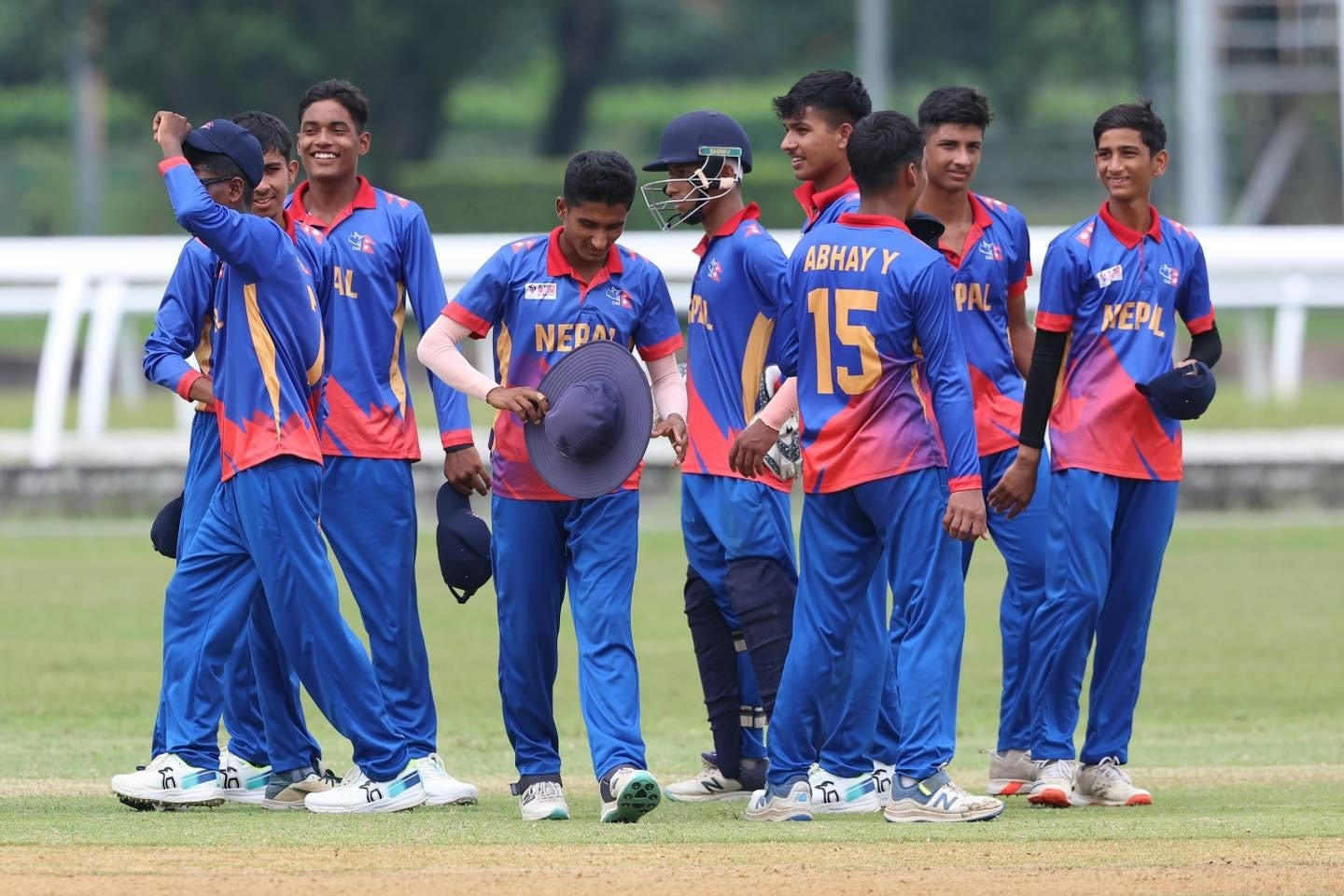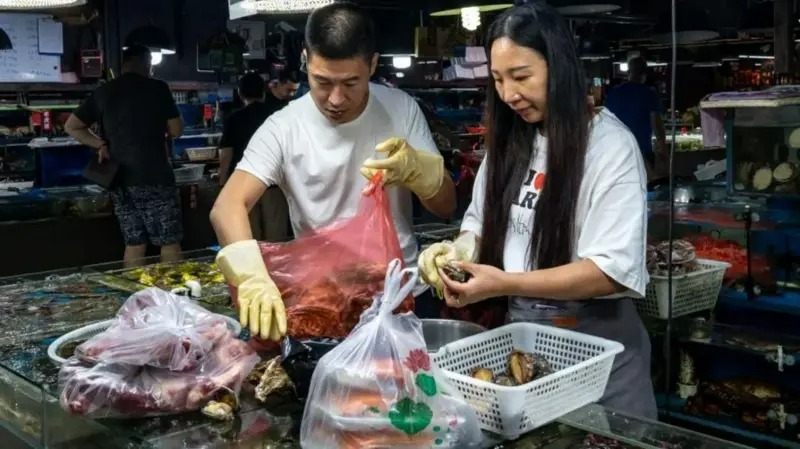The mythical origins of Hadigaun’s jewelry searching festival: An Interview with ancient town’s Shaiva Priest
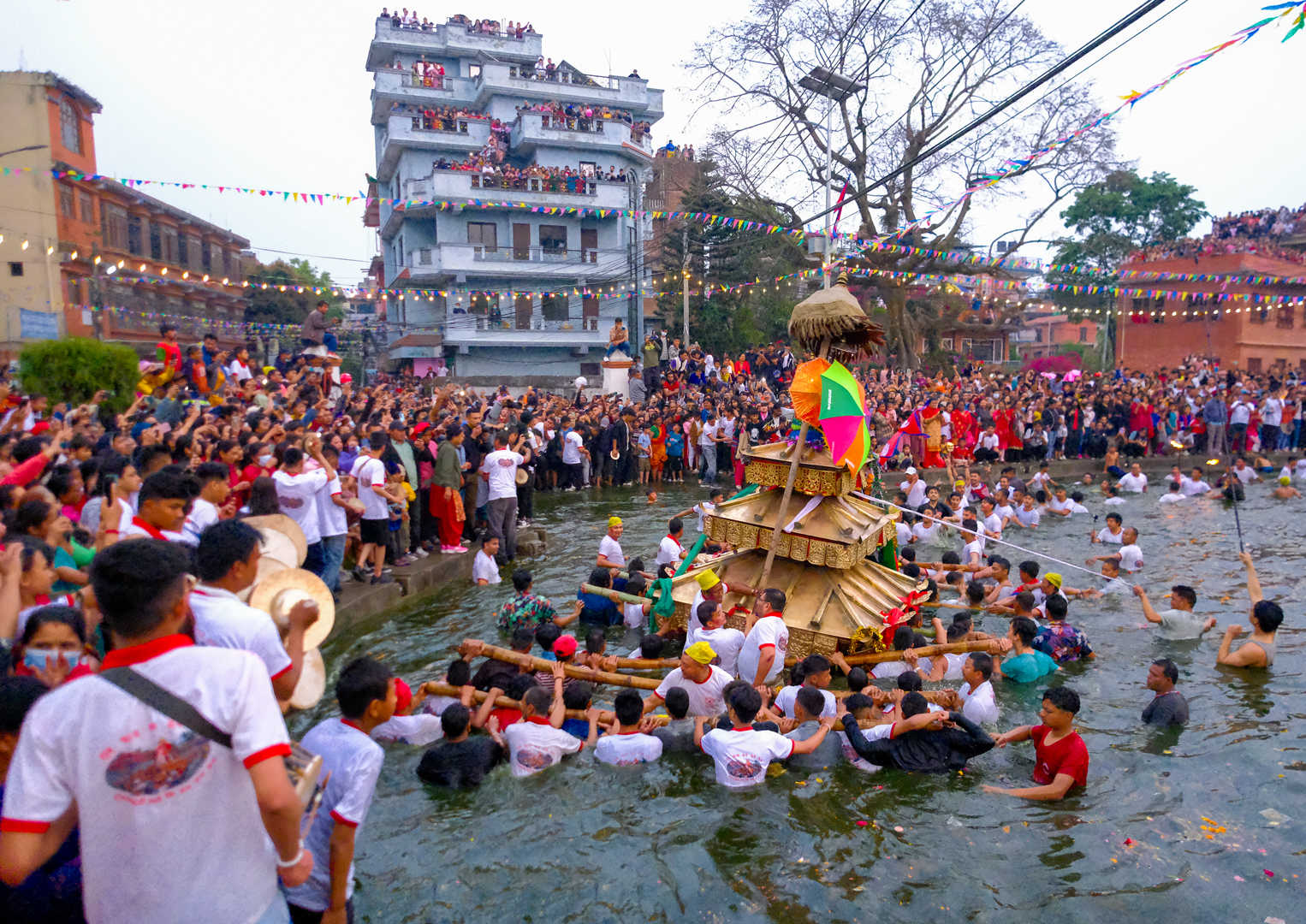
Kathmandu, April 7. The ancient town of Hadigaun in Kathmandu is known for its unique and vibrant forms of festivals, one of which is the famous “Gahana Khojne Jatra” celebrated in the Gahana Pokhari pond. During this festival, devotees carry a palanquin of Tudal Devi on their shoulders and enter the pond, symbolizing the search for her lost jewel.
But before diving into the festivities, understanding the legend behind Tudal Devi is crucial. In an interview with DC Nepal, Bijay Prakash Karma Acharya, a Shaiva priest from Hadigaun, shared captivating stories about the origin of Tudal Devi and her lost jewel, adding to the mystery and allure of the festival. Youth musicians fill the streets of Hadigaun with the melodies of traditional Newari instruments during the vibrant Gahana Khojne Jatra. All Photos: Simon Paudel/ DC Nepal
Youth musicians fill the streets of Hadigaun with the melodies of traditional Newari instruments during the vibrant Gahana Khojne Jatra. All Photos: Simon Paudel/ DC Nepal
The Legend of Too-Na-Dhyah and the Birth of Tudal Devi
In the interview, priest Karma Acharya shared an intriguing story about the origin of “Tudal Devi,” a feminine manifestation of one of the Hindu gods.
The story dates back to the Treta Yuga, a period believed to be the third of the four Yugas when Lord Ram and his brother Lakshman were on a 14-year exile from the kingdom of Ayodhya. While wandering around present-day Baluwatar in Kathmandu, the brothers came across a sugarcane forest where they rested due to fatigue. Despite their thirst, they refrained from stealing sugarcane and instead rested between the sugarcane plants near a river.
While they were resting, an old woman appeared before them and, seeing their exhaustion, cut two sugarcanes and gave them to the brothers. They found the sugarcane so delicious that they felt reinvigorated after drinking its juice. As they ate the sugarcane, the woman disappeared.
Ram was curious about the woman’s miraculous disappearance and, through his meditative vision, saw that she was a devi, a manifestation of the Hindu goddess. He didn’t know her name, so he named her “Too-Na-Dhyah.” “In Newari, Too means sugarcane and Na means eating. Therefore, Too-Na-Dhyah literally denoted the manifestation who gave sugarcane to eat,” Karma Acharya explained.
Years later, a temple was built near the Tukucha(Ichhumati) River where the Devi fed Ram and Lakshman the sweetest sugarcane. As time passed, “Too-Na-Dhyah” became “Tudal Devi,” and the temple became a place of worship for many devotees.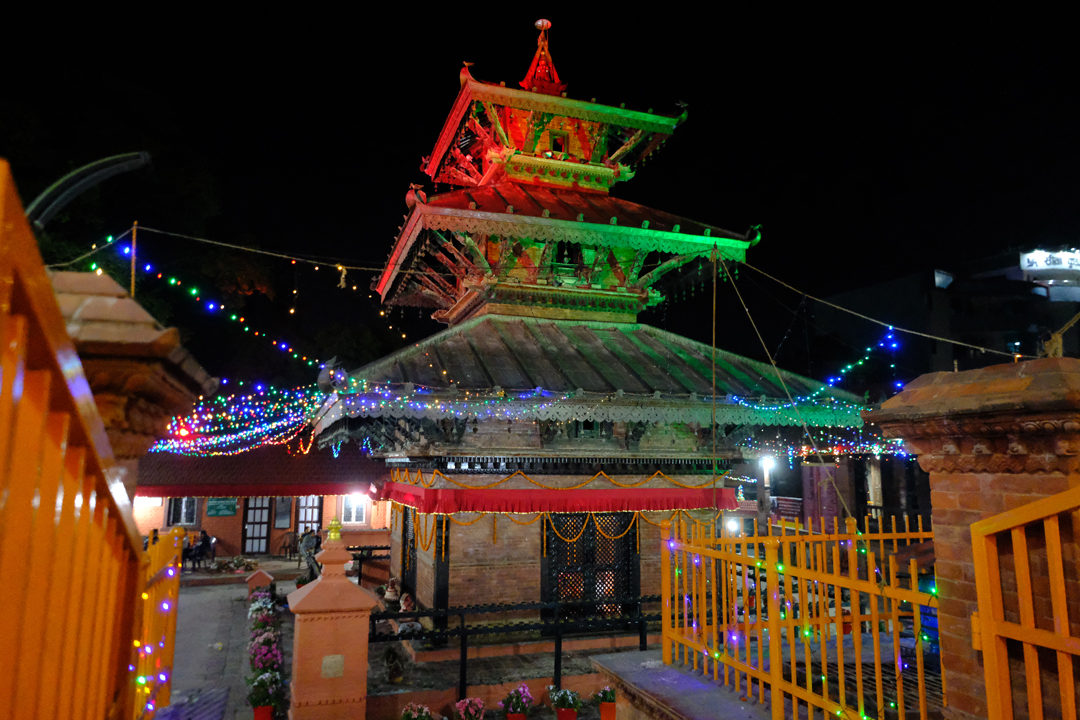 The temple of Tudal Devi shines in the festive lights on the eve of Gahana Khojne Jatra.
The temple of Tudal Devi shines in the festive lights on the eve of Gahana Khojne Jatra.
Interesting Tale – Tudal Devi and her lost Jewelry
According to Karma Acharya, Tudal Devi is also known as “Vaishno Devi”, and she is a manifestation of the mother goddess Durga. Hindu tradition recognizes eight feminine manifestations of the goddess called “Astamatrika,” which means “eight divine mothers.”
The story goes that one day, three of the Astamatrika – Bhairavi, Mahalakshmi, and Vaishno Devi – were flying above the Nepal kingdom when they spotted a beautiful lake. The three sisters decided to come down to earth for a swim. After swimming for hours, they came out of the lake in the late evening. That’s when Vaishno Devi realized that she had lost one of her ornaments.
It is believed that during the evening and night, Asur Shakti (negative energies like ghosts and demons) become stronger and more active, while the positive divine powers become weaker. Therefore, it was important for the goddesses to find the lost jewel before evening, as it would have made the task much more difficult.
Knowing that the negative energies of Asur Shakti were prevailing, Bhairavi was sent back to her home in the distant town of Nuwakot. The two sisters, Mahalakshmi and Vaishno Devi decided to search for the lost jewelry together. Mahalakshmi guarded the lake outside, while Vaishno Devi went inside the lake to search for her lost jewel.
After a while, Vaishno Devi found her jewelry and went to rest in the adjacent Handigaon Dabali. Mahalakshmi went back to her home in Naxal, and two days later, she flew to Nuwakot to meet Bhairavi and share the good news. Bhairavi was overjoyed and declared a celebration to commemorate the happy occasion.
Gahana Khojne Jatra: a festival to search for jewelry
The festival of Gahana Khojne Jatra is an annual event that honors the Tudal Devi and relives the moment when her jewelry was lost and then found. The Jatra begins on Chaitra Shukla Ashtami, which fell on March 29 this year, with the erection of a ceremonial pole called “Lingo”.
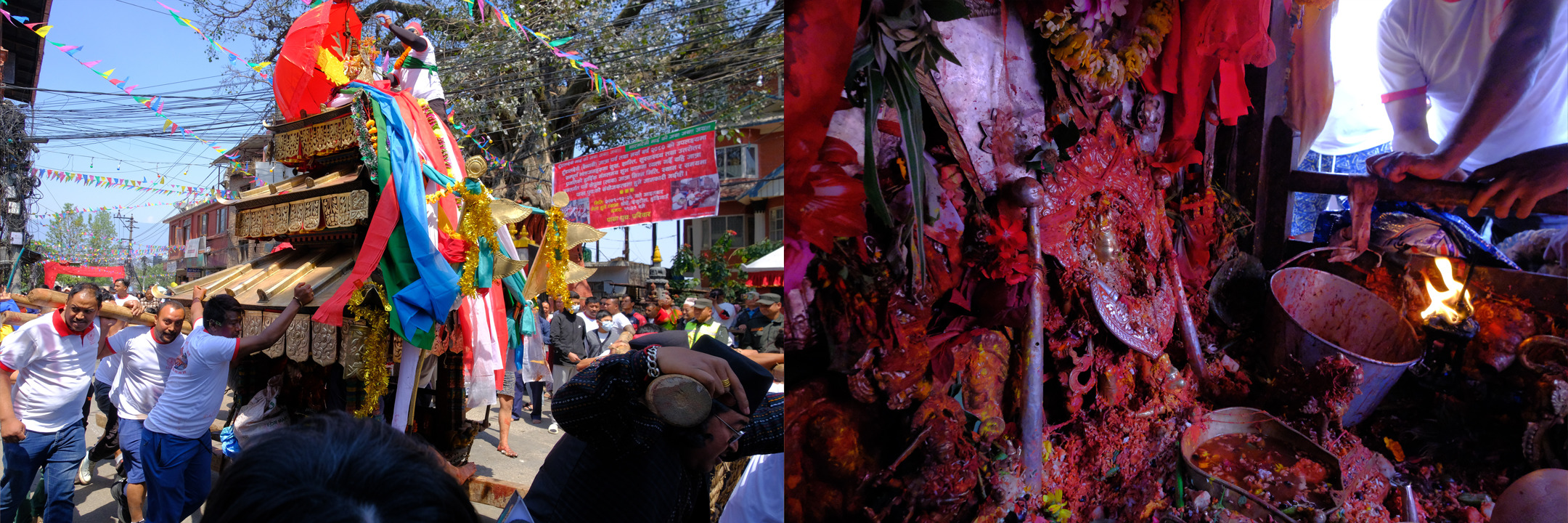 The palanquin(left) and the idol(right) of Tudal Devi.
The palanquin(left) and the idol(right) of Tudal Devi.
This year, the main day of the Jatra was observed today, April 7.
During the primary day of the Jatra, the idol of Tudal Devi is placed on a palanquin and carried on shoulders through the town of Hadigaun. The palanquin is stopped several times at the doorstep of houses marked with red mud.
 Women of a house paint a section of road in front of their home to request that the jatra stops the palanquin in front of their house.
Women of a house paint a section of road in front of their home to request that the jatra stops the palanquin in front of their house.
 A homeowner woman waits for the Tudaldevi palanquin to arrive in front of her house. The palanquin stops in front of many houses that are marked with red mud. After the homeowner worships the idol of Tudaldevi, the palanquin moves on to the next house.
A homeowner woman waits for the Tudaldevi palanquin to arrive in front of her house. The palanquin stops in front of many houses that are marked with red mud. After the homeowner worships the idol of Tudaldevi, the palanquin moves on to the next house.
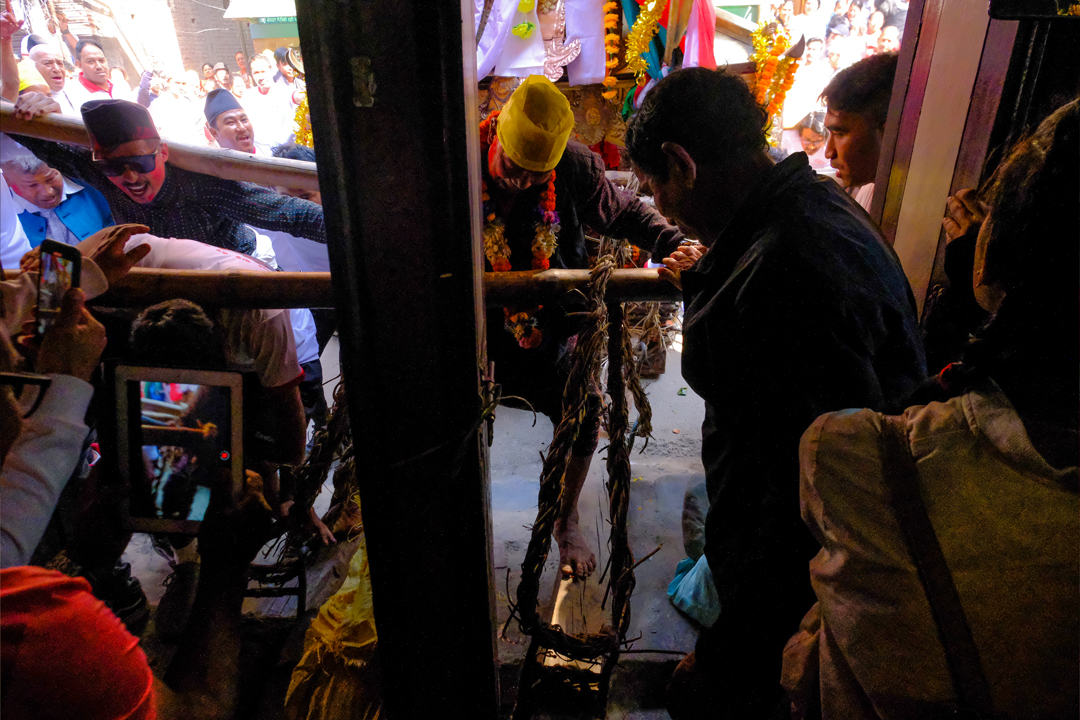 On the way to Gahana Pokhari pond, the palanquin of Tudal Devi is stopped at a few selected houses to be thumped on the wall of the house.
On the way to Gahana Pokhari pond, the palanquin of Tudal Devi is stopped at a few selected houses to be thumped on the wall of the house.
When the palanquin reaches Gahana Pokhari, it is carried into the pond, with the main leader of the Jatra leading the way and the devotees pulling the palanquin three rounds above the water. Meanwhile, the Mane Khat or the palanquin with Mahalaxmi is circled several times around the pond to guard against Asur Shakti.
“According to belief, after three rounds, the jewelry is found. However, no jewelry is thrown into the pond nor searched for,” Karma Acharya said. Once the jewelry is assumed to be found, Tudal Devi is brought to Hadigaun Dabali to rest, and the Mane Khat of Mahalaxmi is taken to the Mahalaxmi temple in Naxal. Two days later, the Mahalaxmi is supposed to be taken to Nuwakot to share the news with Bhairavi.
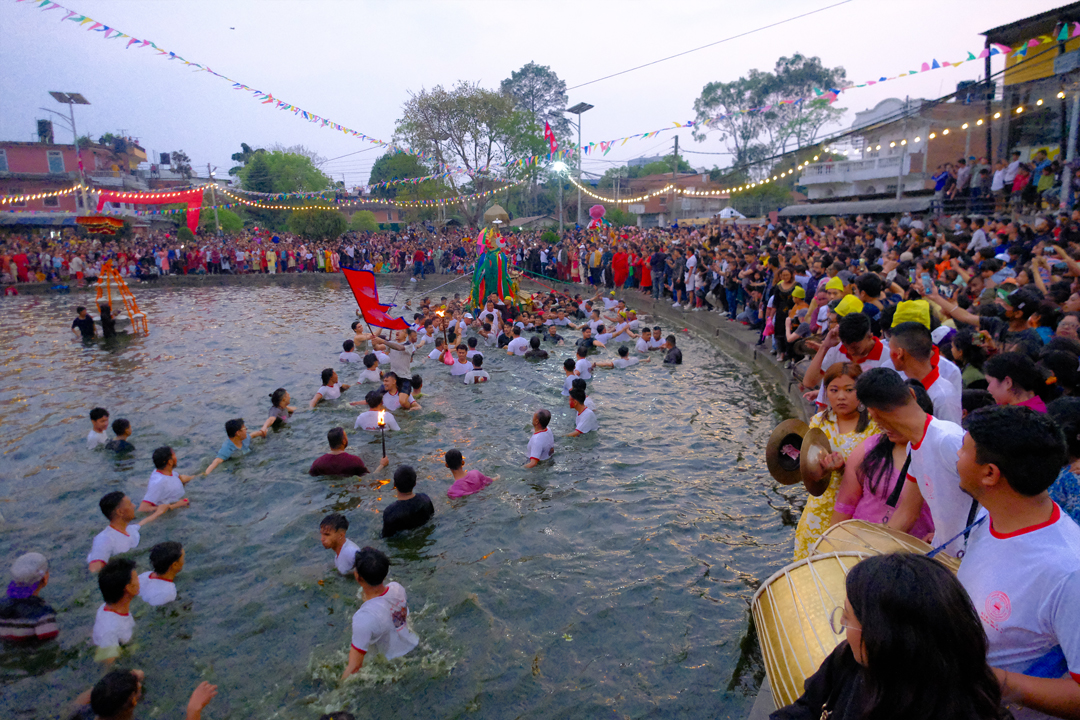 Devotees carry Tudal Devi’s palanquin on the waters of Gahana Pokhari pond.
Devotees carry Tudal Devi’s palanquin on the waters of Gahana Pokhari pond.
 Mane Khat, the palanquin of Mahalaxmi, encircles the pond while Tudal Devi enters the water to search for the lost jewelry.
Mane Khat, the palanquin of Mahalaxmi, encircles the pond while Tudal Devi enters the water to search for the lost jewelry.
 Tudal Devi’s palanquin is being carried to Hadigaun Dabali to rest after being taken out of the pond.
Tudal Devi’s palanquin is being carried to Hadigaun Dabali to rest after being taken out of the pond.
Past – Now: The tale of today
The traditions of today are changing, and as a result, they are losing their original value. In the past, the Mane Khat (Mahalakshmi) was carried on the shoulders of people from Hadigaon to Nuwakot – a distance of approximately 60 kilometers – in order to share good news with Bhairavi. However, in recent decades, instead of the palanquin, only prasad offerings were taken to Nuwakot. Nowadays, the tradition of visiting Nuwakot has come to an end. Despite the change, celebrations continue in Nuwakot, albeit without the delivery of the message.
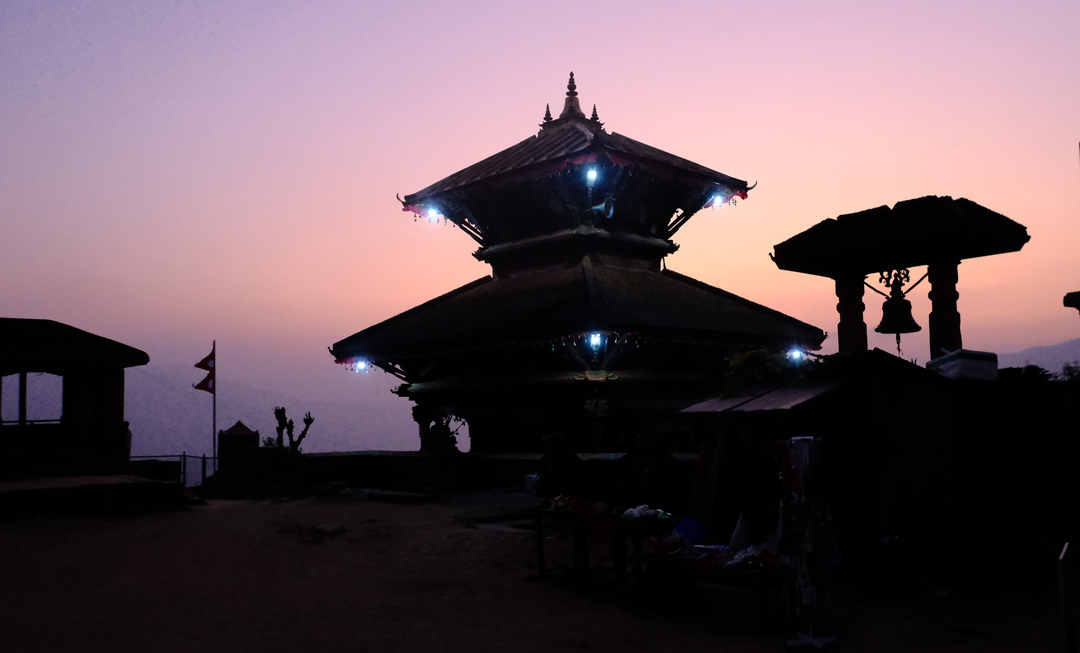 The Bhairavi temple is located in the ancient town of Nuwakot, which is situated about 60 kilometers from Kathmandu.
The Bhairavi temple is located in the ancient town of Nuwakot, which is situated about 60 kilometers from Kathmandu.
Once upon a time, our civilization had a remarkably rich cultural heritage. When a society has access to resources such as food and basic necessities, it can invest time and energy into religion, culture, and celebration. Our culture was once exceptionally prosperous, reflecting the abundance of our past in terms of food, religion, culture, and way of life. Karma Acharya explained, “Some 800 years ago, the Malla kings observed the tradition of taking out idols of gods on a “Jat Yatra” procession around towns in India. They brought this concept to Kathmandu, and the “Jatra”, a kind of festival, was born.” The kings realized that during leisure time, people were more susceptible to overconsumption of alcohol or engaging in fights. By organizing the Jatra festival, they aimed to create harmony and bring people together.
To create this feeling of harmony, it is necessary for the festival to be embraced by every caste and family. Therefore, during a Jatra, each family is given a specific role in the festival. For instance, Karma Acharya’s family was given the responsibility of looking after the tantric manifestations, while the neighboring Dangol family was tasked with preparing rice sculptures two days before the searching festival. “Every family has been assigned a role in the festival, which brings them together and fosters a sense of community. Therefore, taking time to participate in Jatra is a way of getting closer to one’s neighbors and community members,” Karma Acharya said.
He further added, “Our culture serves as an integral part of our identity, and as such, we must pass on our cultural traditions to future generations, showcasing to the world our rich cultural history.”
Karma Acharya reminds us that if we fail to preserve our cultural values, we risk losing our own identity.
Facebook Comment
latest Video
Trending News
- This Week
- This Month


